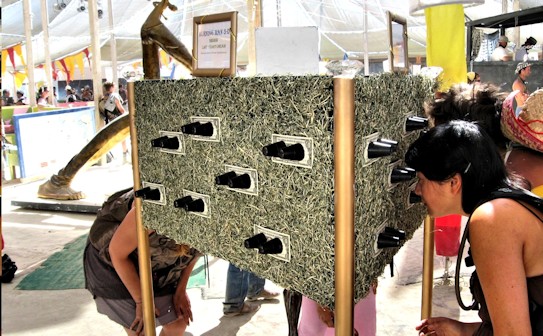
Most people are not aware that 3D, in the form of stereoscopic imaging, was invented just before the invention of photography. The two were immediately combined and the stereoscope was the virtual reality and home entertainment of 150 years ago. I had always like 3D things, maybe because for the first through third grade I went to a one room school house in rural Michigan. It was made of field stone and had many old things, including hundreds of stereoview cards and a few stereoscopes. I use to sit and look that them instead of going out to play. It was like being transported into the past, and in 3D. In 1988, trying hard to procrastinate writing my dissertation, I bought a vintage 1954 Kodak Stereo camera (pictured above). I was instantly hooked. I couldn't understand why anyone would take flat photos! Stereoscopic photography, and 3D movies, had brief popularity in the early 1950's. During that period there were dozens of 3D cameras, and 3D projectors. They were designed to use slow slide film. These cameras, like all from that era, were completely manual.
I had great fun with my hobby of 3D photography, but I was poor and had to be creative. For example I made a 3D projector by hacking two old 1960's slide projectors into one. Later I was able to afford a pair of Pentax P30t SLRs with 50mm manual focus lenses. The challenge of using two separate camera for stereo is that you must synchronize the shutters to thousandths of a second. I bought the Pentax P30t's because it was the least expensive that had auto exposure. I noticed that the shutter was triggered electrically, although the cable release was mechanical. It occurred to me that I might be able to make a switch to synchronize them. I took two mechanical cable releases, replaced the cable with wire, then soldered the wires to a switch. To my amazement it worked perfectly!
I acquired a few more vintage 3D cameras, they are things of beautiful engineering and design. Then in the early 1990's the Soviet Union was failing and Russian cameras were becoming available in the US. The Soviet Union had been making a people's 3D camera in the late 1980's, it was called the FED Stereo. It was better than the US 1950's cameras for two reasons, it had auto exposure and it shot in European stereo format. The US stereo format (Realist Format) consists of two narrow images, each 5/8th the width of a standard slide image. Essentially portrait format. The FED has images 7/8th of a full frame. When I got my FED I was amazed at how poorly it was made. I wondered why we were so afraid of the Soviets, but it became my primary camera. I also have a Soviet era Sputnik camera, a medium format stereo introduced in 1957, the year of the first human made satellite. I almost always shot with Kodachrome 64.
My photography is occasionally good, but I'm not a great photographer and definitely an amateur. I would never accept money for photography, because it would not longer be fun. In the early 2000's I entered Photographic Society of America competitions and won a few awards, but lost interest in doing that. In 1998 and 1999 I experimented with 3D video, to disastrous result.
For my first Burning Man in 1996 I took both my trusty Kodak Stereo and the FED, but I didn't take a lot of slide film. I was only there Friday afternoon through Sunday and missed most events and art. I didn't know what I was doing. As example, I didn't think to take my camera along when we went to Pepe's opera! In 1997 I used a Realist 45 and the FED, I took more film and made it an objective to take photos of the art and performances. That started a tradition of photo journalism. I wanted to make a visual record of Burning Man. In 1997 I also experimented with infra-red film, but knew nothing of using infra red filters, so ended up with strange looking magenta slides. My favourite image from 1996 was of the toddler daughter of my camp mate and co-worker, that I call "Growling Tiger on the Playa." I thought I would make it a standard part of the gallery each year to have a kid photo. Unfortunately the only shot I got of kids in 1998 was awful, so that tradition ended. In 1998 and 2001 I experimented with black and white slide film. Today that seems like a waste because it is so easy to convert digital to black and white, but on slide film color was very different from black and white. I also used the medium format Sputnik 2000 through 2003.
I used my Pentax P30t's for years at Burning Man to shoot hyper stereos of the burn. Most 3D shots need camera separation that matches average human eye separation. More than that is called "hyper stereo" and less is called "hypo" or macro stereo. If the lenses are much further apart than human eyes, then you can't shoot close objects. To get 3D effect of objects at a distance you need to increase the separation between lenses. Shooting the burn I would use distances of two to six feet between cameras. Over the years I made a real effort to capture the art and the feel of Burning Man. As the event has grown that has become almost impossible. You can't even come close to getting it all. In 2001 I was up all night and found that dawn was the perfect time to get shots of most of the art. Since then I have gotten up before dawn one day in the week, to get photos of the art with good lighting, fewer people, and before it is destroyed or burned.
Around 2001 digital cameras were starting to become affordable. I wanted to twin a pair of digitals for stereo. I naively thought that you could just solder the shutter buttons together. I bought two Hewlett-Packard Photo Smart 318 cameras, with a whopping 2.3 mega pixels. I then pressured my friend Jeremy Lutes to solder them for me, not only did that stress our friendship, it was also a waste of time and money. It didn't work. It is actually much more difficult to synchronize the shutters of digital cameras than it is mechanical cameras. The reason is that each digital device has its own internal clock, to get reasonable synch the clocks need to be close. I gave up on digital for a while.
Digital stereo photography became a reasonable goal in 2005. There was a way to connect certain Sony cameras. It was called the LANC Shepard controller. It didn't actually synchronize the internal processor clocks, instead it provided a readout that would show when they were in synch. You could press a single button to start both cameras, and if lucky they would start up in close synchronization. Often they would not. You could then either shut them down and try again, or wait for the clocks to drift into synchronism. That could take minutes. I bought two Sony DSC-V1 five mega pixel cameras. The whole system was rather expensive. I got the LANC Shepard and a custom made Z-bar. A Z-bar is a mount that puts one camera upside down. Why would you do that? Well in stereo photography the distance between the lenses is critical. If your lenses are much more than 2.5 inches apart, then you can't take photos of things that are close. With most digital cameras flipping one upside down lets you get the lenses closer together. Even with the Z-bar the Sony DSC-V1's had an 85mm (3.5 inch) stereo base, which meant that you couldn't take photos of things closer than about 9 feet. Well, technically you could take the photo, but trying to view it in 3D would be painful or impossible.
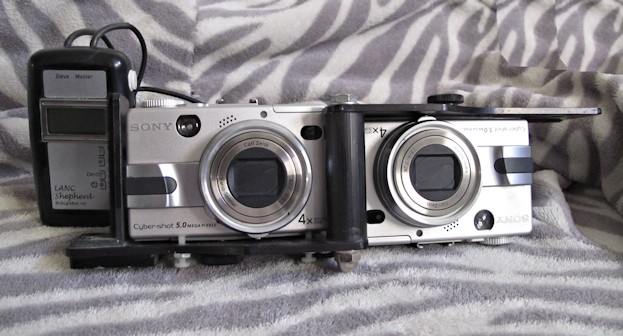
The next advance in amateur stereo digital photography came as a gift from some Russian hackers. Someone figured out how to get Canon PowerShot cameras to dump the operating system. Then they figured out how to program them. It's called CHDK (Canon Hack Development Kit) and a variation on it was created called Stereo Data Maker (SDM). This hack produces very precise synchronization of shutter release. It works rather simply. First the hacked operating system is loaded through the SD memory card. The cameras are linked through the USB port, with wires attached to a simple switch and a five volt battery. When five volts is detected the cameras go into a loop that is ended when the switch is released, and the shutters fire. The effect is that both cameras shoot within a few multiples of the processing speed of the chip. In other words, close to 1/10,000th of a second. In 2008 I retired the expensive Sony DSC-V1 system after just 3 years. My first pair of Canon SDM synced cameras were 5 MP PowerShot A570's. I made the Z-bar myself. The Canons worked well, they were not as good under low light compared to the Sony's, but they could be used for spontaneous and action shots. No waiting or missed shots because the cameras were not in sync. People will not wait for your cameras. The SDM synced cameras could do more that take photos of stationary art works. The Sony rig could not. During these transition years I continued to bring the FED Stereo and shoot some slide film.
Rumors were flying in 2009 of a consumer digital 3D camera to be introduced by Fuji. Finally a real digital 3D camera. Stereo photography enthusiasts hoped for a renaissance of popularity of 3D photography, like the popularity brought on by the introduction of the Stereo Realist in 1947. The camera was called the FujiFilm FinePix Real 3D W1. The camera was never sold in the US. I ordered one from Japan for a high price and had it shipped by express to get it before Burning Man 2009. It was a 10MP camera with a glasses-free (auto-stereoscopic) 3D display. It was much easier to use than a pair of cameras linked by a switch. Unfortunately it was not designed to withstand playa dust. On the night of the burn one image was just black, not a stereo pair. Then it failed completely and there was playa dust under the screen. As soon as I got home I ordered another one, then just a few months later Fuji introduced the W3 , an improved model that was sold in the US. There have been many other, lesser quality stereo cameras. None of them has done well in the market place. Just as 3D TVs have quickly been replaced by better selling models. I also have the HTC Evo 3D smart phone, its close lens spacing make it good for close ups. It also features auto-stereoscopic screen and failed to sell well. The dream of a strong revival of 3D remains elusive.
The Fuji W3 is great but I also need a higher quality stereo camera that can be used for hyper shots. So I twinned a pair of Canon G11s. More flexibility and creativity. I've always been frustrated with the difficulty of sharing the stereo images. In the slide film days I would give a slide with a plastic viewer, but that is not practical with digital. So I decided to make lenticular prints. Lenticular prints are those plastic covered 3D prints that don't require glasses. Lenticular prints require more images, usually six or more. So I bought four more Canon G11s, a custom SDM switch, and made three brackets for using the six cameras with different stereo bases. Below is a picture of me with the six camera rig. The idea was to take stereo shots of great art, make prints, and send them to the artists. I managed to deliver prints to the makers of The Neverwas Haul, the Armadillo mutant vehicle, and Zack Cofin, but some others have not found their artist.
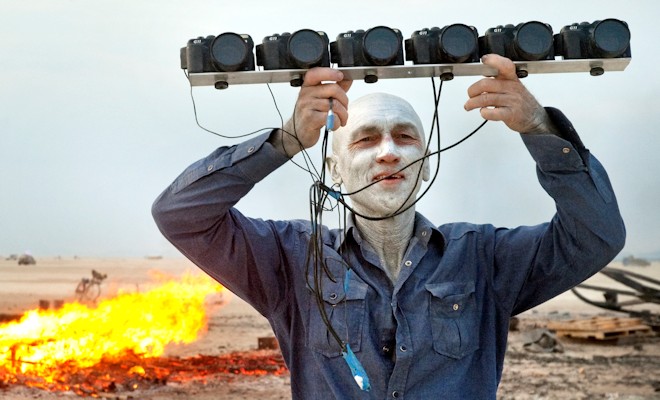
In 2014 I put together a pair of Canon G1X cameras. They have a large sensor and SLR like quality. My creative challenge for 2015 was to use 180 degree wide angle fisheye lenses to create stereo images to view with the Oculus Rift or other VR devices. The effect is more like being in the image than looking at it, because you're able to look around. In 2018 I bought a Lenovo Mirage VR180 camera. The Mirage takes wide angle stereo pairs and video much like using 180 fisheye lenses on my G1X twin camera rig. It saves the stereo images in a new format "VR180" which unfortunately, is not well supported. At first the only way to share the images is to upload them to a gallery on Google Photo. There were no viewers for your own web pages. Google seemed to only be interested in allowing users to use the images and videos through their on line service. Essentially severely limiting users by not providing a full platform. Imagine if Kodak photos could only be seen using Kodak viewers. Progress has been made, there are utilities for changing VR180 formats and VR social platforms like AltspaceVR provide some ways to share VR180 images and video.
My Canon G1X cameras are becoming full of dust after at least seven trips to Burning Man. In 2022 bought a pair of Sony R0X II cameras. They are much like a GoPro because they are small and rugged, built to stand up to playa dust. A big advantage is that they are small enough to give you a 60mm stereo base without having to turn one upside down. I 3D printed a bracket for them that allows 60-80mm stereo base. They are good cameras but the Canon G1X is much better for low light and night photography. The Sony RX0 II cameras are too noisy in low light.
I intend to focus more effort on capturing the fireball when the Man burns. It is difficult. The cameras need to be separated by six to eight feet, perfectly synchronized, and you must fire them when the fireball explodes. There isn't a signal, you have to be lucky. I have a pair of Canon EOS T5 that might do the trick in burst mode. Having the right equipment is only part, you also need to be on a stable platform above the crowd with nothing in front of the cameras.
Stereo cameras are not the only way to make 3D. To make a stereoscopic image with computer graphics you just render two images with the virtual camera shifted on the x axis the correct amount between images. First 3D imaging software that I tried, in the early 1990's, was Persistence of Vision Ray Tracer (POV-ray). POV is a free script language rendering program. You create beautiful 3D images with programming code! I've used to create images that combine stereo photographs with computer generated environments. I used it to make this animated gif of the man that appeared at the top of my Burning Man 3D galleries 1999-2002. Each "board" that makes up the Man is described by a line of code as a rectangle of specific dimensions and positioned in 3D coordinates.
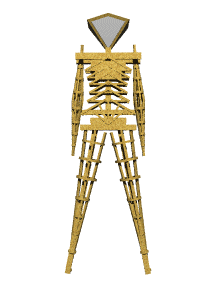
POV-ray is great but also limiting. I had other ideas for images using the Man, so I modeled the Man using Wings 3D, then finished in Blender. In 2007 I had a concept for the Burning man theme "Green Man." It was the green man confronting greed. Greed was represented by a gold geometric figure. My plan was to make a computer graphic each year to represent the theme. I didn't like the 2008 theme of "The American Dream." My concept was the Man being swallowed up by liquid gold. Blender has good particle and fluid simulation. To get the desired effect I created a 300 frame animation of the Man falling into a bowl of liquid. The image is one frame (a left and right for stereo) of the animation where the fluid splashed around the man. I rendered the image using the very realistic LuxRender. Each image took over 96 hours to render on my then powerful desktop, a Pentium Q6600. The image was very good in 3D. The theme for 2009 was one that I liked a lot, Evolution. My idea was to recreate the classic evolving man illustration, but using the Burning Man figure. Nice idea but difficult to create. I spent countless hours mutating the model of the Man to look like earlier evolved species. When finished I didn't like it much. My concept for Metropolis was the skyline of San Francisco where every building was Burning Man. I never got around to making it, so the tradition ended. You can see them in stereo in the 2007 through 2009 galleries.
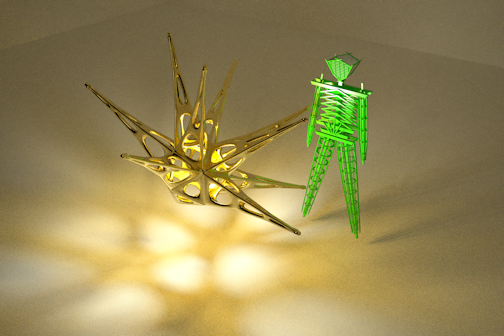
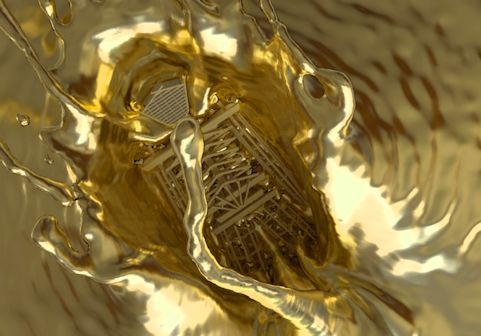
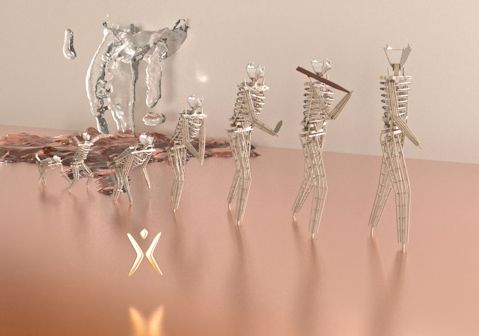
Lots of things go wrong at Burning Man. It is a hostile environment for man, beast, and camera. I already mentioned how my first Fuji W1 died the night of the burn. The worst thing though was having my FED Stereo stolen. That was a harsh wake up call to the fact that Burning Man is not the close knit group of friends that it was in the 1980's and 90's. In 2004 I went to set up my display of 3D images in the center camp cafe. I brought my FED Stereo because it was my main camera and I took it everywhere. After the display was set up a guy who looked like a neo-hippie stereotype, insisted on giving me his "special hug." The hug was more than a bit uncomfortably long. After he and his friends left I realized my camera was gone. It had a roll of film in it with photos of the maze under the Man. I still had the Sony DSC-V1 system, but that wasn't good for taking photos quickly or close photos of people. At the Critical Tits party I tried to use my film SLRs cameras side-by-side for stereo. The stereo base was too extreme and none of those photos could be viewed in 3D.
The second worst disaster happened in 2002. During the after party for the Critical Tits ride I stopped to reload my FED Stereo. It was dusty and I was covered in gold make up. Unknown to me at the time, something got on the shutters. The camera advanced the film and it sounded like the shutters were working. But they were not. For the rest of Burning Man I thought I was taking photos, but they were blank. Eight rolls of slide film. Imagine the horror when I got them back from processing! Digital has its advantages! I barely had enough images to make a gallery that year.Photography always has challenges. In 2018 I found that my switch controlling my six Cannon G11 cameras was not working. Sometimes the cameras would fire together, but usually not.
A camera obscura is a magical thing. You are inside a giant camera. A lens with a long focal length throws an image of the outside onto a surface. Very simple, yet oddly mesmerizing. From a cynical perspective a camera obscura is useless. Okay, so you can see what is outside, why don't you just step outside and look! Nonetheless, they are fascinating. Camera obscuras were very popular at the turn of the 20th century, before the advent of television and movies.
I had the idea of making one that was stereoscopic. I don't think it had ever been done before. It worked by using polarizing filters and 3D glasses, just like the ones used for 3D movies. With the help of many people, including Bob Stahl, we made a working stereoscopic camera obscura at Burning Man in 2000 and 2001, see the galleries for those years for a photo. Both years the camera was not complete until the end of the week and few people were able to experience it. That was mostly due to Bob being constantly called away to do tasks for the DPW. If I do it again it will be built before getting to the playa, then assembled. I have the lenses and ideas for how to design it. Maybe someday I'll do a kickstarter to make it happen.
I've shared the art of stereoscopy with Burners in a variety of other ways. I've given 3D slide shows using an old 1950's stereoscopic slide projectors at Burning Man and at the San Francisco Decompression. I displayed my images in small 3D viewers, sort of like individual View-Master viewers. I first displayed them that way outside our camp in 2002. In 2003 I put the display in front of Camp Carp on the Esplanade. Then in 2004, I moved it into the center camp cafe. I had a display in center camp each year for six year, 2004 through 2009. The 3D photo display from 2008 is shown in the photo below. To satire the theme of the american dream I covered the display with shredded US currency and to framed each viewer with a dollar bill. The gold color posts are topped with a glass diamond. Those were stolen in the first few days that the display was in center camp.
